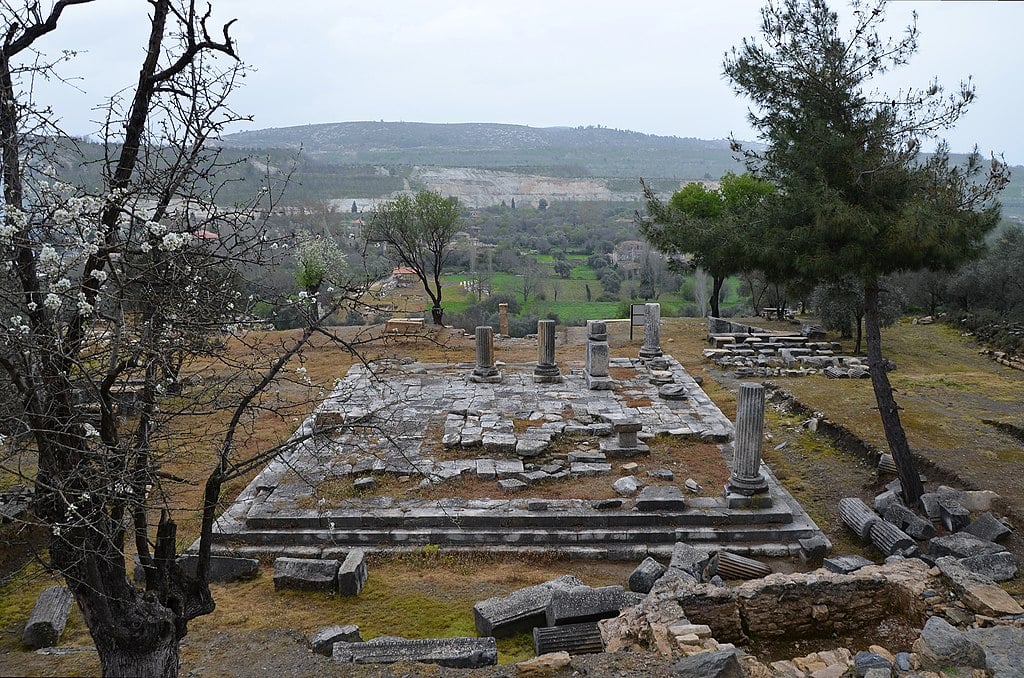

A sarcophagus decorated with garlands, believed to be 2,000 years old, has been unearthed during excavations at the ancient city of Stratonikeia, located in the western province of Muğla’s Yatağan district in Turkey.
Listed on UNESCO’s World Heritage Tentative List and known as the “City of Gladiators” as well as one of the world’s largest marble cities, Stratonikeia has been the site of ongoing excavations since 1977.
The ancient city holds significance not only for the Hellenistic, Roman and Byzantine periods but also for the Menteşe Beylik, Ottoman and Republican eras.
Muğla Yatağan’da bulunan Gladyatörler kenti” Stratonikeia Antik Kenti’nde 2 bin yıl öncesine ait girlandlı lahit bulundu
pic.twitter.com/M5bmm1U4Es
— Basileos (@arkeologbirey) April 27, 2025
Professor Bilal Söğüt, head of the Stratonikeia and Lagina Excavation Team, said, “One of these projects is the excavations we are conducting at the Agora—the central public space for political, religious and commercial activities surrounded by public buildings. In the Agora, we are excavating remains from the Late Antiquity period.
“During these excavations, we found a sarcophagus adorned with garlands—a wreath composed of fruits, flowers and leaves—that had previously been relocated from the Necropolis [the city’s cemetery] and dates back around 2,000 years,” the Turkish professor said according to Hurriyet.
2,000-Year-Old Garlanded Sarcophagus Unearthed in Stratonikeia Ancient City
During ongoing excavations at the ancient city of Stratonikeia, located in the Yatağan district of Muğla, Türkiye a 2,000-year-old sarcophagus adorned with garlands has been uncovered.
Professor Dr.… pic.twitter.com/6Eic9VucOL
— History Content (@HistContent) April 27, 2025
Stating that the sarcophagus is one of the finest examples in the ancient city’s sarcophagus collection, Söğüt said that there is evidence suggesting that sarcophagi were not only produced in the city but also transported elsewhere.
Söğüt explained, per Hurriyet, that ram heads were found on the corners of the sarcophagus, while Eros figures—depicted as childlike representations of the god of love—and bull heads adorned the central sections.
He said, “This sarcophagus is one of the best examples among garland-decorated pieces, both in terms of the variety of figures and the clarity with which we can date it. With this find, we now have the finest sarcophagus tub discovered in Stratonikeia.”
Emphasizing that the figures around the sarcophagus remain remarkably vivid, Söğüt said, “It is possible to see all the wealth, grandeur and splendor of 2,000 years ago reflected here.
The plants, especially the garlands, are beautifully crafted and richly detailed. Around the corners, motifs of pinecones, vine and olive leaves, grapes, pomegranates and poppies are depicted. Even just by looking at the ram heads on the corners, one can sense the richness and magnificence of the era. The bull heads on the narrow sides and central sections complete the set of intricate decorations.”
According to ancient Greek Geographer Strabo, the ancient city of Stratonikeia was founded by the Seleucid king Antiochus I Soter (281–261 BC), a Greek ruler from the dynasty that emerged after the conquests of Alexander the Great. Antiochus named the city after his wife, Stratonice, which translates as “Victorious Army,” reflecting the Seleucids’ cultural and political legacy rooted in Alexander’s empire.
The city, one of the largest marble cities in the world, has been a treasure trove of archaeological discoveries. According to UNESCO, “Stratonikeia has been known as the city of eternal love and gladiators throughout the ages. It was a center where gladiators were trained, did demonstrations, and spent their life after retirement.”
